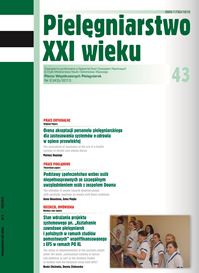Knowledge of midwives on the hospital infections in terms of insertion and care of peripheral needles
Keywords:
midwives knowledge, hospital infections, prevention, peripheral vessels cannuling, vascular catheterAbstract
KNOWLEDGE OF MIDWIVES ON THE HOSPITAL INFECTIONS IN TERMS OF INSERTION AND CARE OF PERIPHERAL NEEDLES
Introduction. Nosocomial infections are a great problem in hospitals in most of countries and despite development of methods of their control, they are still present at quite high level. It necessitates possessing well-defined procedures and their implementation by well-trained personnel and also monitoring their effectiveness.
Aim. The aim of this work was to determine midwives' knowledge in scope of hospital-acquired infections in the context of inserting and caring for peripheral insertions.
Material and method. The study group consisted of 96 midwives employed in hospitals in the Podkarpackie region . The study was performed using a diagnostic survey based on the authors’ questionnaire. The research was performed from November 2009 to February 2010. The results were processed using statistical program Statistica 8.0 and Chi² Test.
Results. Most midwives did not complete the course for nosocomial infections. Only half of the respondents know the correct technique of blood vessel catheterization. Midwives after graduation from undergraduate studies stated that the nosocomial infection is a clinical diagnosis and a laboratory-confirmed infection that occurs during hospitalization and is revealed during the patient's stay in hospital; the same responses were given by people after graduation from medical post-secondary school (p = 0.05). Among the respondents, 85% of midwives always use single-use gloves when setting vascular catheters, which may be related to the fact that have not registered a catheter infection p = 0.0003).
Conclusions. Knowledge of many midwives on hospital infections is inadequate. Consequently, it is necessary to have a higher level of education on the causes and prevention of nosocomial infections, especially on catheter-related infections. It is necessary to conduct regular training on hospital infections in any health care institution.
References
1. Żaczek R, Iwaniec T, Dziura M. Profilaktyka zakażeń wynikających z kaniulacji naczyń obwodowych. Pielęgniarstwo XXI wieku. 2007; 2(19): 111-115.
2. Fleischer M, Bober-Gheek B. Podstawy Pielęgniarstwa Epidemiologicznego. Wrocław: Wyd. Med. Urban&Partner; 2006: 164-165, 406.
3. Kiljan-Staszałek E, Korbal P, Szymański W. Zakażenia szpitalne w oddziale noworodków trzeciego stopnia w latach 2001-2002 - doświadczenia własne. Kliniczna Perinatologia i Ginekologia. 2005; 41(1): 68-72.
4. Mitkowska Z, Kwinta P. Kaniulacja żył obwodowych i centralnych u noworodków. Medycyna Praktyczna Pediatria. 2000; 3: 166-174.
5. Fortun J i wsp. A critical approach to the pathogenesis, diagnosis, treatment and prevention of catheter-related bloodstream infections and nosocomial andocarditis. Clin Microbiol Infect. 1999; 5: 40-50.
6. Czarnecka J, Krupienicz A. Ryzyko zakażenia związane z cewnikowaniem dożylnym a czas utrzymania cewnika w żyle. Pielęgniarstwo Polskie. 2008; 2(28): 111-114.
7. Dz. U. 2008 Nr 234 poz. 1570.
8. Stein A, Makarawo T, Ahmad M. A survey of doctor’s and nurses’s knowledge, attitudes and compliance with infection control guidelines in Birmingham teaching hospitals. J Hosp Infect. 2003; 54: 68-73.
9. Nobile C, Montuori P, Diaco E et al. Healthcare personnel and hand decontamination in intensive care units: knowledge, attitudes and behavior in Italy. J Hosp Infect. 2002;51: 226-232.
10. Boyce J, Pittet D. Guideline for hand hygiene in healthcare settings: Recommendations of the Healthcare infection Control Practices Advisory Committee and the HICPAC/SHEA/APIC/IDSA Hand Hygiene Task Force. Am J Infect Control. 2002; 30: 1-46.
11. Książek J, Wilichnowska B, Gaworska- Krzemień A i wsp. Wiedza pielęgniarek i działania praktyczne z zakresu profilaktyki zakażeń miejsc kaniulacji żył obwodowych- doniesienia wstępne. Probl Hig Epidemiol. 2007; 88(2): 230-234.
12. Sierakowska M, Ciżewska C, Szafran D i wsp. Profilaktyka zakażeń wewnątrzszpitalnych – ocena procedury kaniulacji naczyń obwodowych. Pielęgniarstwo XXI wieku. 2003; 5: 73-78.
13. LeMaster CH, Schuur JD, Pandya D et al. Infection and natural history of emergency department-placed central venous catheters. Ann Emerg Med. 2010; 56(5): 492-7.
14. Safdar N, Kluger DM, Maki DG. A review of risk factors for catheter-related bloodstream infection caused by percutaneously inserted, noncuffed central venous catheters: implications for preventive strategies. Medicine. 2002; 81(6): 466-79.
15. Garus A, Szatko F. Przestrzeganie wzorców zachowań higienicznych przez personel medyczny w szpitalach. Probl. Hig. Epidemiol. 2006; 87(3): 176 -181.
16. Warren DK, Zack JE, Mayfield JL et al. The effect of an Education Porgram on the Incidence of Central Venous Catheter-Associated Blood-stream Infection in a Medical ICU. Chest. 2004; 126(5): 1612-19.
17. Zingg W, Imhof A, Maggiorini M et al. Impact of a prevention strategy targeting hand hygiene and catheter care on the incidence of catheter-related bloodstream infections. Crit Care Med. 2009; 37(7): 2167-73.
18. Lobo RD, Levin AS, Oliveira MS et al. Evaluation of interventions to reduce catheter-associated bloodstream infection: continuous tailored education versus one basic lecture. Am J Infect Control. 2010; 38(6): 440-8.
19. Labeau SO, Vandijck DM, Rello J et al. Evidence Study Investigators. Centers for Disease Control and Prevention guidelines for preventing central venous catheter-related infection: results of a knowledge test among 3405 European intensive care nurses. Crit Care Med. 2009; 37(1): 320-3.
20. Sannoh S, Clones B, Munoz J et al. A multimodal approach to central venous catheter hub care can decrease catheter-related bloodstream infection. Am J Infect Control. 2010; 38(6): 424-9.
Downloads
Published
Issue
Section
License
Copyright (c) 2013 Bernadeta Kołodziej, Edyta Barnaś, Romana Wróbel, Anna Kremska (Autor)

This work is licensed under a Creative Commons Attribution 4.0 International License.




